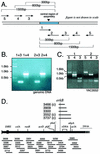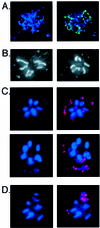Sequence and structure of the extrachromosomal palindrome encoding the ribosomal RNA genes in Dictyostelium
- PMID: 12711681
- PMCID: PMC154234
- DOI: 10.1093/nar/gkg348
Sequence and structure of the extrachromosomal palindrome encoding the ribosomal RNA genes in Dictyostelium
Abstract
Ribosomal RNAs (rRNAs) are encoded by multicopy families of identical genes. In Dictyostelium and other protists, the rDNA is carried on extrachromosomal palindromic elements that comprise up to 20% of the nuclear DNA. We present the sequence of the 88 kb Dictyostelium rDNA element, noting that the rRNA genes are likely to be the only transcribed regions. By interrogating a library of ordered YAC clones, we provide evidence for a chromosomal copy of the rDNA on chromosome 4. This locus may provide master copies for the stable transmission of the extrachromosomal elements. The extrachromosomal elements were also found to form chromosome-sized clusters of DNA within nuclei of nocodazole-treated cells arrested in mitosis. These clusters resemble true chromosomes and may allow the efficient segregation of the rDNA during mitosis. These rDNA clusters may also explain the cytological observations of a seventh chromosome in this organism.
Figures




References
-
- Karrer K.M. and Gall,J.G. (1976) The macronuclear ribosomal DNA of Tetrahymena pyriformis is a palindrome. J. Mol. Biol., 104, 421–453. - PubMed
-
- Maizels N. (1976) Dictyostelium 17S, 25S, and 5S rDNAs lie within a 38,000 base pair repeated unit. Cell, 9, 431–438. - PubMed
-
- Cockburn A.F., Newkirk,M.J. and Firtel,R.A. (1976) Organization of the ribosomal RNA genes of Dictyostelium discoideum: mapping of the non transcribed spacer regions. Cell, 9, 605–613. - PubMed
-
- Vogt V.M. and Braun,R. (1976) Structure of ribosomal DNA in Physarum polycephalum. J. Mol. Biol., 106, 567–587. - PubMed
Publication types
MeSH terms
Substances
Associated data
- Actions
- Actions
- Actions
Grants and funding
LinkOut - more resources
Full Text Sources
Molecular Biology Databases

